Comparing the Selection and Placement of Best Management Practices in Improving Water Quality Using a Multiobjective Optimization and Targeting Method
Abstract
:1. Introduction
2. Materials and Methodology
2.1. Study Site

2.2. SWAT Model Development
2.3. BMP Scenarios
2.4. Multiobjective Genetic Algorithm Model


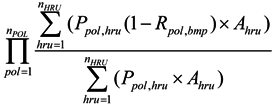

2.5. Sensitivity Analysis and Estimation of GA Parameters
| Parameter | Population | Number of Generations | Crossover Probability | Mutation Probability |
|---|---|---|---|---|
| Default | 100 | 1,000 | 0.9 | 0.0001 |
| Optimal for different allele sets | ||||
| 171 BMPs (All) | 5,000 | 40,000 | 0.9 | 0.001 |
| NG BMPs | 3,000 | 40,000 | 0.5 | 0.001 |
| OG BMPs | 5,000 | 40,000 | 0.9 | 0.001 |
| SP BMPs | 3,000 | 40,000 | 0.7 | 0.001 |
| SU BMPs | 3,000 | 40,000 | 0.9 | 0.001 |
| VFS0 BMPs | 5,000 | 40,000 | 0.7 | 0.001 |
| VFS42 BMPs | 3,000 | 40,000 | 0.5 | 0.001 |
2.6. Targeting Method
3. Results and Discussion
3.1. Sensitivity and Estimation of GA Parameters


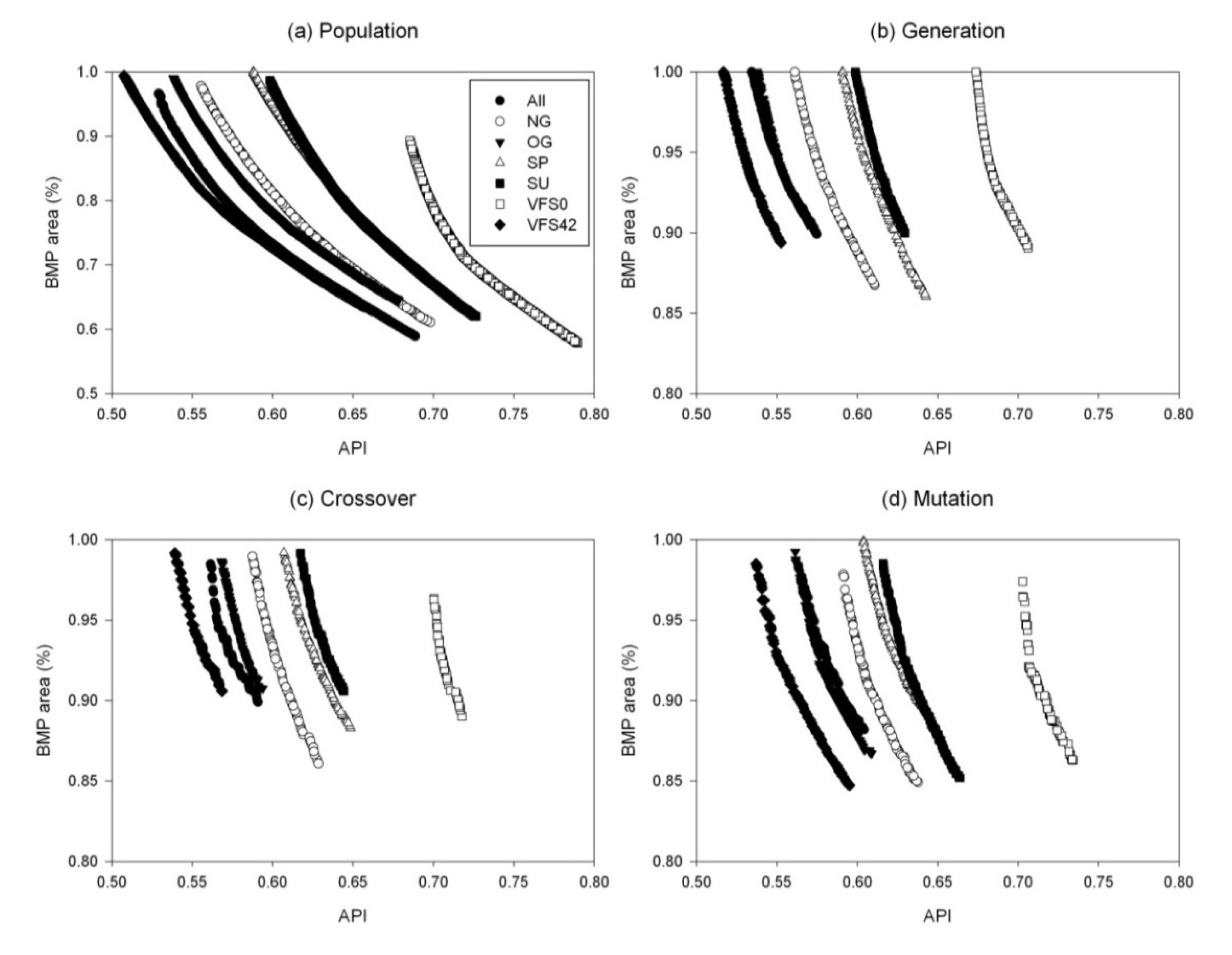
3.2. Performance of the Optimization Tool and the Targeting Method
| BMP Options | TN Load (kg/ha) | BMP Area(%) | TP Load (kg/ha) | BMP Area(%) |
|---|---|---|---|---|
| ALL | 3.39 | 0.77 | 0.74 | 0.77 |
| NG | 3.36 | 0.82 | 0.70 | 0.82 |
| OG | 3.41 | 0.75 | 0.74 | 0.75 |
| SP | 3.51 | 0.78 | 0.75 | 0.78 |
| SU | 3.77 | 0.74 | 0.79 | 0.74 |
| VFS0 | 3.75 | 0.82 | 1.11 | 0.82 |
| VFS42 | 3.38 | 0.77 | 0.77 | 0.77 |
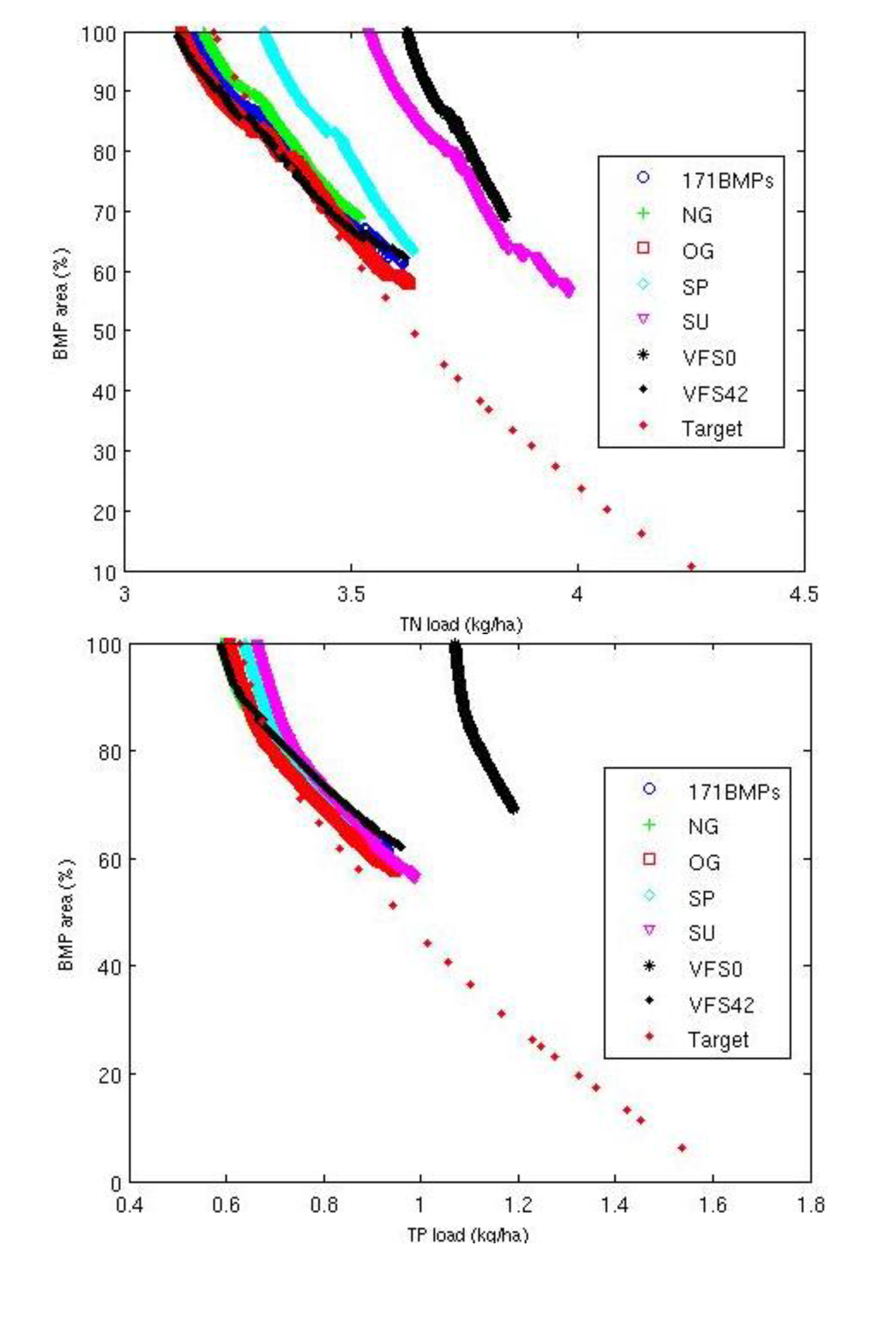
3.3. Comparison of Selection and Placement of BMPs
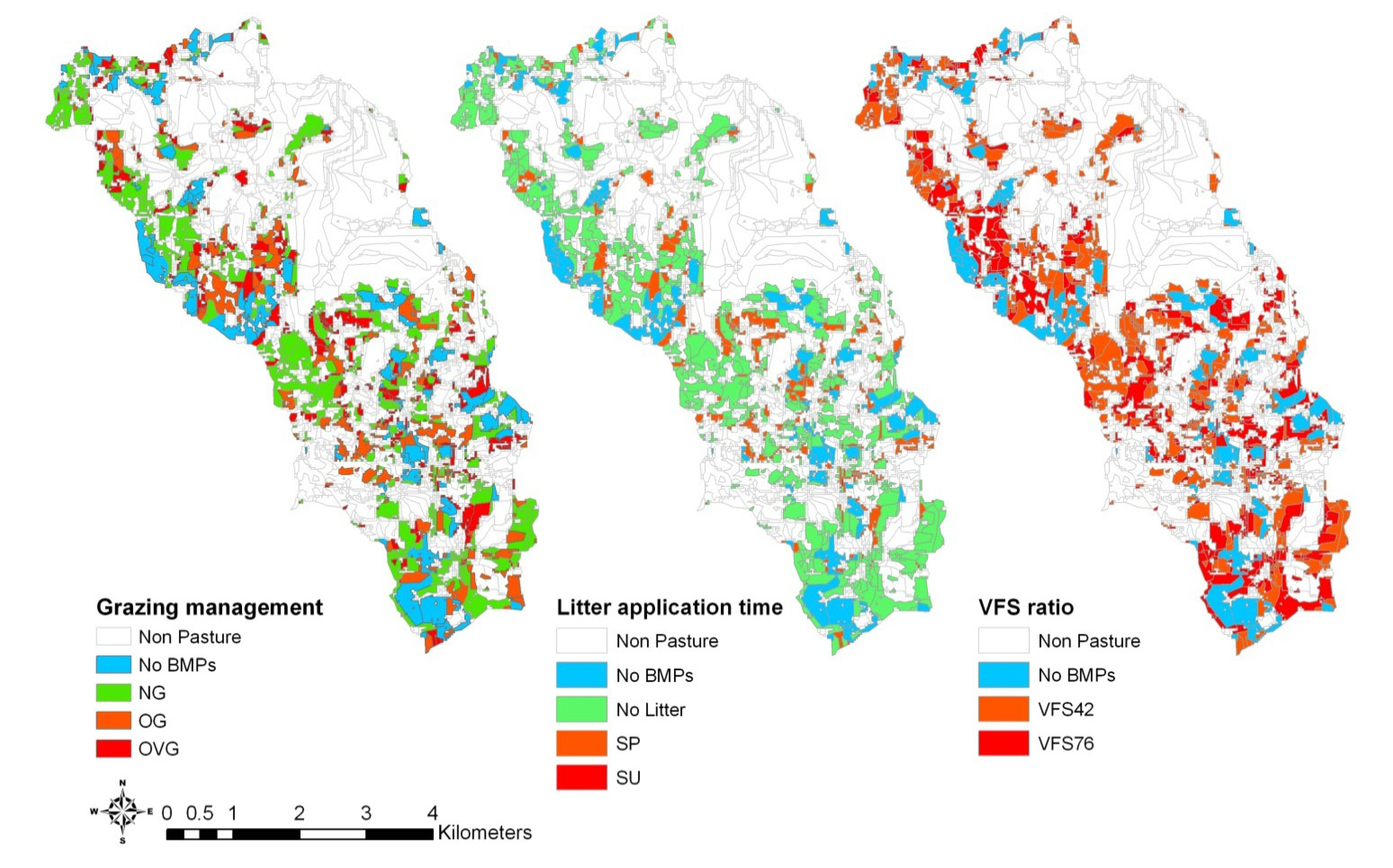
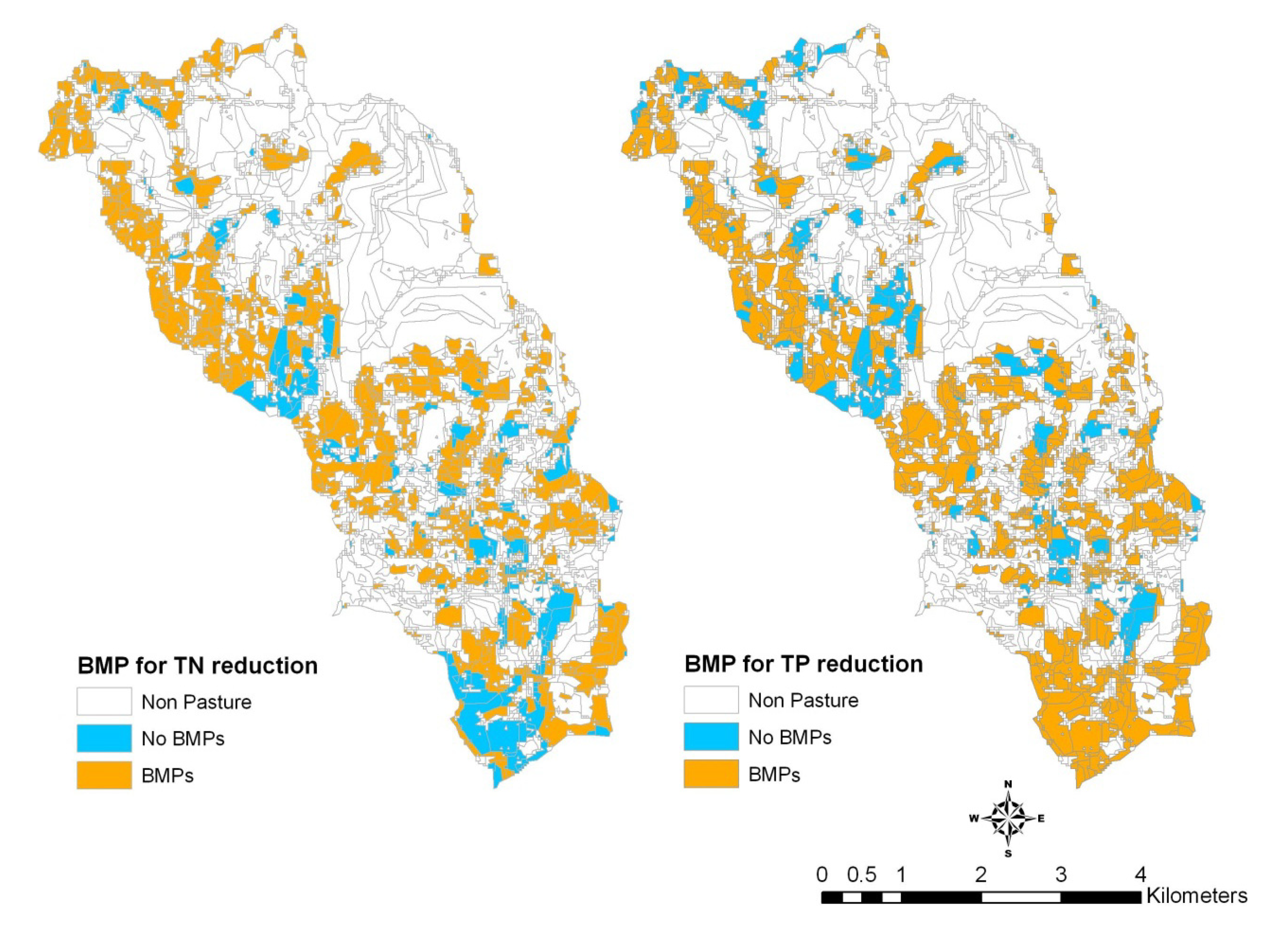
| BMP options | TN Load (kg/ha) | BMP Area(%) | TP Load (kg/ha) | BMP Area(%) |
|---|---|---|---|---|
| Baseline | 4.55 | 0.00 | 1.66 | 0.00 |
| ALL | 3.39 | 0.77 | 0.74 | 0.77 |
| NG | 3.39 | 0.80 | 0.72 | 0.80 |
| OG | 3.39 | 0.77 | 0.73 | 0.77 |
| SP | 3.39 | 0.89 | 0.68 | 0.89 |
| SU | 3.54 | 1.00 | 0.66 | 1.00 |
| VFS0 | 3.62 | 1.00 | 1.07 | 1.00 |
| VFS42 | 3.39 | 0.75 | 0.78 | 0.75 |
4. Conclusions
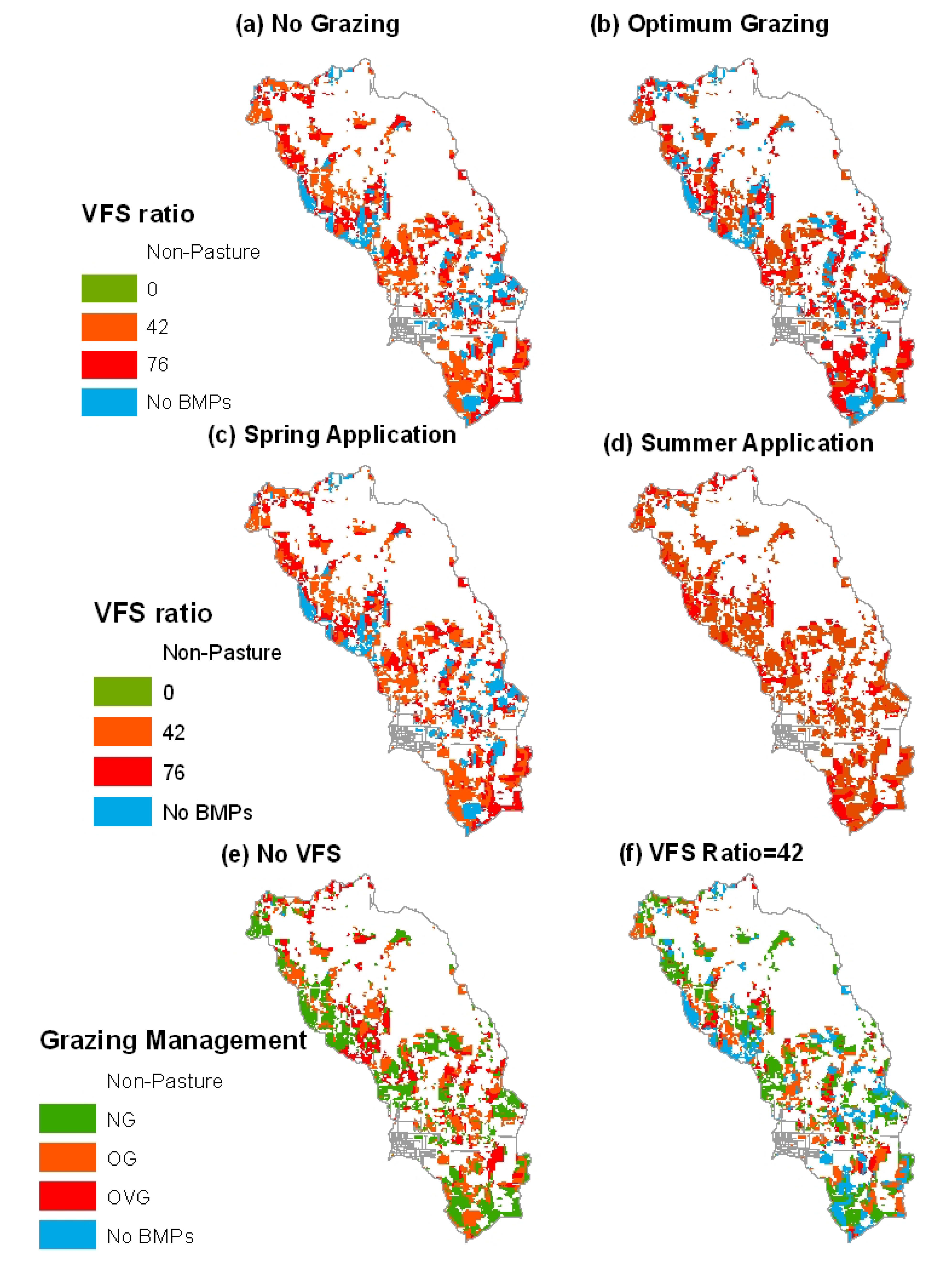
Author Contributions
Conflicts of Interest
References
- Harmel, R.D.; Torbert, H.A.; Haggard, B.E.; Haney, R.; Dozier, M. Water quality impacts of converting to a poultry litter fertilization strategy. J. Environ. Qual. 2004, 33, 2229–2242. [Google Scholar] [CrossRef]
- Yu, C.; Northcott, W.J.; McIsaac, G.F. Development of an artificial neural network for hydrologic and water quality modeling of agricultural watersheds. Trans. ASAE 2004, 47, 285–290. [Google Scholar] [CrossRef]
- Alexander, R.B.; Smith, R.A.; Schwarz, G.E.; Boyer, E.W.; Nolan, J.V.; Brakebill, J.W. Differences in phosphorus and nitrogen delivery to the Gulf of Mexico from the Mississippi river basin. Environ. Sci. Technol. 2008, 42, 822–830. [Google Scholar] [CrossRef]
- Chiueh, P.T.; Shang, W.T.; Lo, S.L. An integrated risk management model for source water protection areas. Int. J. Environ. Res. Public Health 2012, 9, 3724–3739. [Google Scholar] [CrossRef]
- Tilman, D.; Cassman, K.G.; Matson, P.A.; Naylor, R.; Polasky, S. Agricultural sustainability and intensive production practices. Nature 2002, 418, 671–677. [Google Scholar] [CrossRef]
- Gillingham, A.G.; Thorrold, B.S. A review of New Zealand research measuring phosphorus in runoff from pasture. J. Environ. Qual. 2000, 29, 88–96. [Google Scholar] [CrossRef]
- Monaghan, R.M.; Paton, R.J.; Smith, L.C.; Drewry, J.J.; Littlejohn, R.P. The impacts of nitrogen fertilization and increased stocking rate on pasture yield, soil physical condition and nutrient losses in drainage from a cattle-grazed pasture. New Zeal. J. Agr. Res. 2005, 48, 227–240. [Google Scholar] [CrossRef]
- Sharpley, A.N.; Chapra, S.C.; Wedepohl, R.; Sims, J.T.; Daniel, T.C.; Reddy, K.R. Managing agricultural phosphorus for protection of surface waters: Issues and options. J. Environ. Qual. 1994, 23, 437–451. [Google Scholar]
- Edwards, D.R.; Daniel, T.C. Potential runoff quality effects of poultry manure slurry applied to fescue plots. Trans. ASAE 1992, 35, 1827–1832. [Google Scholar] [CrossRef]
- U.S. Environmental Protection Agency (USEPA). National Management Measures to Control Nonpoint Source Pollution from Agriculture: EPA 841-B-03–004; U.S. Environmental Protection Agency: Washington, DC, USA, 2003.
- Santhi, C.; Srinivasan, R.; Arnold, J.G.; Williams, J.R. A modeling approach to evaluate the impacts of water quality management plans implemented in a watershed in texas. Environ. Model. Softw. 2006, 21, 1141–1157. [Google Scholar]
- Arabi, M.; Govindaraju, R.S.; Hantush, M.M. A probabilistic approach for analysis of uncertainty in the evaluation of watershed management practices. J. Hydrol. 2007, 333, 459–471. [Google Scholar] [CrossRef]
- Chiang, L.C.; Chaubey, I.; Hong, N.M.; Lin, Y.P.; Huang, T. Implementation of BMP strategies for adaptation to climate change and land use change in a pasture-dominated watershed. Int. J. Environ. Res. Public Health 2012, 9, 3654–3684. [Google Scholar] [CrossRef]
- Green, C.H.; Arnold, J.G.; Williams, J.R.; Haney, R.; Harmel, R.D. Soil and water assessment tool hydrologic and water quality evaluation of poultry litter application to small-scale subwatersheds in texas. Trans. ASABE 2007, 50, 1199–1209. [Google Scholar] [CrossRef]
- Rodríguez, H.G.; Popp, J.; Maringanti, C.; Chaubey, I. Selection and placement of best management practices used to reduce water quality degradation in lincoln lake watershed. Water Resour. Res. 2011, 47, 1–13. [Google Scholar] [CrossRef]
- Vaché, K.B.; Eilers, J.M.; Santelmann, M.V. Water quality modeling of alternative agricultural scenarios in the us corn belt. J. Am. Water Resour. Assoc. 2002, 38, 773–787. [Google Scholar] [CrossRef]
- Pionke, H.B.; Gburek, W.J.; Sharpley, A.N. Hydrologic and Chemical Controls on Phosphorous Loss from Catchments; CAB International Press: Cambridge, UK, 1997; pp. 225–242. [Google Scholar]
- Veith, T.L.; Wolfe, M.L.; Heatwole, C.D. Cost-effective BMP placement: Optimization vs. targeting. Trans. ASAE 2004, 47, 1585–1594. [Google Scholar] [CrossRef]
- Behera, S.; Panda, R.K. Evaluation of management alternatives for an agricultural watershed in a sub-humid subtropical region using a physical process based model. Agric. Ecosyst. Environ. 2006, 113, 62–72. [Google Scholar] [CrossRef]
- Tripathi, M.P.; Panda, R.K.; Raghuwanshi, N.S. Development of effective management plan for critical subwatersheds using SWAT model. Hydrol. Process. 2005, 19, 809–826. [Google Scholar] [CrossRef]
- Giri, S.; Nejadhashemi, A.P.; Woznicki, S.A. Evaluation of targeting methods for implementation of best management practices in the Saginaw river watershed. J. Environ. Manage. 2012, 103, 24–40. [Google Scholar] [CrossRef]
- Maringanti, C.; Chaubey, I.; Popp, J. Development of a multiobjective optimization tool for the selection and placement of best management practices for nonpoint source pollution control. Water Resour. Res. 2009, 45. [Google Scholar] [CrossRef]
- Srivastava, P.; Hamlett, J.M.; Robillard, P.D.; Day, R.L. Watershed optimization of best management practices using annagnps and a genetic algorithm. Water Resour. Res. 2002, 38, 1–14. [Google Scholar]
- Veith, T.L.; Wolfe, M.L.; Heatwole, C.D. Optimization procedure for cost effective BMP placement at a watershed scale. JAWRA 2003, 39, 1331–1343. [Google Scholar]
- Gitau, M.W.; Veith, T.L.; Gburek, W.J. Farm-level optimization of BMP placement for cost-effective pollution reduction. Trans. ASAE 2004, 47, 1923–1931. [Google Scholar] [CrossRef]
- Arabi, M.; Govindaraju, R.S.; Hantush, M.M. Cost-effective allocation of watershed management practices using a genetic algorithm. Water Resour. Res. 2006, 42, 1–8. [Google Scholar]
- Shen, Z.; Chen, L.; Xu, L. A topography analysis incorporated optimization method for the selection and placement of best management practices. PLoS One 2013, 8. [Google Scholar] [CrossRef]
- Oraei Zare, S.; Saghafian, B.; Shamsai, A. Multi-objective optimization for combined quality–quantity urban runoff control. HESS 2012, 16, 4531–4542. [Google Scholar]
- Green, W.R.; Haggard, B.E. Phosphorus and Nitrogen Concentrations and Loads at Illinois River South of Siloam Springs, Arkansas, 1997–1999; Branch of Information Services, U.S. Geological Survey: Denver, CO, USA, 2001. [Google Scholar]
- Gitau, M.W.; Chaubey, I. Regionalization of SWAT model parameters for use in ungauged watersheds. Water 2010, 2, 849–871. [Google Scholar] [CrossRef]
- Edwards, D.R.; Daniel, T.C.; Scott, H.D.; Murdoch, J.F.; Habiger, M.J.; Burks, H.M. Stream quality impacts of best management practices in a northwestern arkansas basin. Water Resour. Bull. 1996, 32, 499–509. [Google Scholar] [CrossRef]
- Chiang, L.; Chaubey, I.; Gitau, M.W.; Arnold, J.G. Differentiating impacts of land use changes from pasture management in a ceap watershed using swat model. Trans. ASABE 2010, 53, 1569–1584. [Google Scholar] [CrossRef]
- Arnold, J.G.; Srinivasan, R.; Muttiah, R.S.; Williams, J.R. Large area hydrologic modeling and assessment part I: Model development. J. Am. Water Resour. Assoc. 1998, 34, 73–89. [Google Scholar] [CrossRef]
- Huang, J.; Zhou, P.; Zhou, Z.; Huang, Y. Assessing the influence of land use and land cover datasets with different points in time and levels of detail on watershed modeling in the north river watershed, china. Int. J. Environ. Res. Public Health 2012, 10, 144–157. [Google Scholar] [CrossRef]
- Gassman, P.W.; Reyes, M.R.; Green, C.H.; Arnold, J.G. The soil and water assessment tool: Historical development, applications, and future research directions. Trans. ASABE 2007, 50, 1211–1250. [Google Scholar] [CrossRef]
- U.S. Geological Survey Geographic Data Download. Available online: http://edc2.usgs.gov/geodata/index.php (accessed on 3 July 2007).
- Land Use/Land Cover Data. Available online: http://www.cast.uark.edu/cast/geostor/ (accessed on 3 July 2007).
- Soil Survey Geographic (SSURGO Database). Available online: http://soildatamart.nrcs.usda.gov/ (accessed on 3 July 2007).
- Neitsch, S.L.; Arnold, J.G.; Kiniry, J.R.; Williams, J.R. Soil and Water Assessment Tool Theoretical Documentation: Version 2005; Grassland, Soil and Water Research Laboratory, Agricultrue Research Service: Temple, TX, USA, 2005. [Google Scholar]
- Pennington, J.H.; Steele, M.A.; Teague, K.A.; Kurz, B.; Gbur, E.; Popp, J.; Rodríguez, G.; Chaubey, I.; Gitau, M.; Nelson, M.A. Breaking ground a cooperative approach to collecting information on conservation practices from an initially uncooperative population. J. Soil Water Conserv. 2008, 63, 206–211. [Google Scholar]
- Nash, J.E.; Sutcliffe, J.V. River flow forecasting through conceptual models part I—A discussion of principles. J. Hydrol. 1970, 10, 282–290. [Google Scholar] [CrossRef]
- Forage and Pasture Forage Management Guides. Self-Study Guide 5: Utilization of Forages by Beef Cattle. Available online: http://www.aragriculture.org/forage_pasture/Management_Guide/Forages_Self_Help_Guide5.htm (accessed on 3 July 2007).
- White, K.L.; Chaubey, I. Sensitivity analysis, calibration, and validations for a multisite and multivariable swat model. J. Am. Water Resour. Assoc. 2005, 41, 1077–1089. [Google Scholar] [CrossRef]
- Lowrance, R.; Dabney, S.; Schultz, R. Improving water and soil quality with conservation buffers. J. Soil Water Conserv. 2002, 57, 36–43. [Google Scholar]
- Conservation Buffers to Reduce Pesticide Losses. Available online: http://pesticidestewardship.org/drift/Documents/Conservbuffers.pdf (accessed on 5 March 2014).
- Naiman, R.J.; Decamps, H.; Pollock, M. The role of riparian corridors in maintaining regional biodiversity. Ecol. Appl. 1993, 3, 209–212. [Google Scholar] [CrossRef]
- Park, Y.S.; Park, J.H.; Jang, W.S.; Ryu, J.C.; Kang, H.; Choi, J.; Lim, K.J. Hydrologic response unit routing in SWAT to simulate effects of vegetated filter strip for South-Korean conditions based on VFSMOD. Water 2011, 3, 819–842. [Google Scholar] [CrossRef]
- Park, Y.S.; Engel, B.A.; Shin, Y.; Choi, J.; Kim, N.-W.; Kim, S.-J.; Kong, D.S.; Lim, K.J. Development of web gis-based VFSMOD system with three modules for effective vegetative filter strip design. Water 2013, 5, 1194–1210. [Google Scholar] [CrossRef]
- Chaubey, I.; Chiang, L.; Gitau, M.W.; Mohamed, S. Effectiveness of best management practices in improving water quality in a pasture-dominated watershed. J. Soil Water Conserv. 2010, 65, 424–437. [Google Scholar] [CrossRef]
- U.S. Department of Agriculture, Natural Resources Conservation Service (USDA-NRCS). Using RUSLE2 for the Design and Predicted Effectiveness of Vegetative Filter Strips (VFS) for Sediment; USDA-NRCS: Washington, DC, USA, 2007.
- Deb, K.; Pratap, A.; Agarwal, S.; Meyarivan, T. A fast and elitist multiobjective genetic algorithm: NSGA-II. IEEE Trans. Evolut. Comput. 2002, 6, 182–197. [Google Scholar] [CrossRef]
- Zitzler, E.; Thiele, L. Multiobjective evolutionary algorithms: A comparative case study and the strength pareto approach. IEEE Trans. Evolut. Comput. 1999, 3, 257–271. [Google Scholar] [CrossRef]
© 2014 by the authors; licensee MDPI, Basel, Switzerland. This article is an open access article distributed under the terms and conditions of the Creative Commons Attribution license (http://creativecommons.org/licenses/by/3.0/).
Share and Cite
Chiang, L.-C.; Chaubey, I.; Maringanti, C.; Huang, T. Comparing the Selection and Placement of Best Management Practices in Improving Water Quality Using a Multiobjective Optimization and Targeting Method. Int. J. Environ. Res. Public Health 2014, 11, 2992-3014. https://doi.org/10.3390/ijerph110302992
Chiang L-C, Chaubey I, Maringanti C, Huang T. Comparing the Selection and Placement of Best Management Practices in Improving Water Quality Using a Multiobjective Optimization and Targeting Method. International Journal of Environmental Research and Public Health. 2014; 11(3):2992-3014. https://doi.org/10.3390/ijerph110302992
Chicago/Turabian StyleChiang, Li-Chi, Indrajeet Chaubey, Chetan Maringanti, and Tao Huang. 2014. "Comparing the Selection and Placement of Best Management Practices in Improving Water Quality Using a Multiobjective Optimization and Targeting Method" International Journal of Environmental Research and Public Health 11, no. 3: 2992-3014. https://doi.org/10.3390/ijerph110302992




